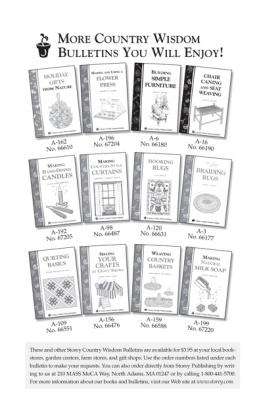S TENCILING
JUDY TUTTLE

The mission of Storey Publishing is to serve our customers by publishing practical information that encourages personal independence in harmony with the environment.
Cover design by Carol J. Jessop (Black Trout Design)
1979 by Storey Publishing, LLC
All rights reserved. No part of this bulletin may be reproduced without written permission from the publisher, except by a reviewer who may quote brief passages or reproduce illustrations in a review with appropriate credits; nor may any part of this bulletin be reproduced, stored in a retrieval system, or transmitted in any form or by any means electronic, mechanical, photocopying, recording, or other without written permission from the publisher.
The information in this bulletin is true and complete to the best of our knowledge. All recommendations are made without guarantee on the part of the author or Storey Publishing. The author and publisher disclaim any liability in connection with the use of this information. For additional information please contact Storey Publishing, 210 MASS MoCA Way, North Adams, MA 01247.
Storey books and bulletins are available for special premium and promotional uses and for customized editions. For further information, please call 1-800-793-9396.
Tuttle, Judy
Stenciling / Judy Tuttle
A Storey Publishing Bulletin, A-34
ISBN 978-0-88266-208-4

Introduction
Time to redecorate? If you had lived 200 years ago in this country, you could have sent word to the itinerant stencil artist to come and spend some time in your home. An excellent alternative to expensive French wallpapers, stenciling would give your home a cheerful and refined effect. You could choose your designs from among the tin or leather stencils carried by the artist, and you probably would have decided upon simple patterns made from leaves, flowers, or fruit. You might have brightened your room with ceiling and baseboard borders, framed your windows and your doorways with repeated patterns, and filled in your open wall areas with stripes or circular designs. You might even have imitated costly carpeting by stenciling your floors.
Interest in stenciling persists today as homemakers seek inexpensive and creative ways to decorate. Stenciling appeals more and more, because design combinations and colors can be varied to suit anyones taste and can be adapted to fit with existing furniture and drape patterns. There is no limit as to where it can be used, since soil and stains can be scrubbed off. With a little practice, anyone can apply the designs to create a unique and interesting room. It is not any more time-consuming than applying wallpaper, and it isnt as messy. Any mistakes you make can be corrected easily. It can be done a little at a time and added to or changed as taste dictates. It requires no expensive equipment, only a desire to have a room that is different from any other and a desire to have fun doing it.
Where to Put It
Stenciling is suitable for any kind of room, both in new and in older homes. Designs can be applied on rough plaster walls, where larger designs are usually more effective, and on smooth walls or wall-board, wood or plaster. Stenciling can be applied to floors or paneling and also is impressive on brick. Old wallpaper can be painted and then stenciled, and if the wallpaper has a texture, the finished product is all the more interesting.
Almost any paint can be used for the background. It can be flat, satin finish, semi-gloss, latex, or oil-based. Stenciling can also be done over wood stains, varnishes, polyurethanes, or shellacs, but slippery materials such as glass, glossy paints, waxed surfaces, and vinyl will resist paint and for that reason shouldnt be used as a base for stenciling.
The paint you use to stencil is easier to work with if it is oil-based. Latex pain dries too quickly and builds up on the stencil.
Area to Cover
In deciding upon a design for your room, you must think about how much area youd like to cover. Would your room look nice with just a border next to the ceiling? If your walls are about 9 feet high, a border as large as 10 inches wide can be used, but if they are 7 feet as in many modern homes, probably your border shouldnt be wider than 7 inches. Your taste can dictate the exact size, and if you begin to apply a border and dont like its size, you can paint it out and try something different.
After you have applied a border, if that is what you chose, consider whether youd like to add more design. Other areas traditionally stenciled are along the tops of baseboards, around doors and windows, along wainscotting, or along the area of wall where a chair rail might be. Various types of designs can be mixed without one detracting from the other.
If you decide youd like an all-over design for your room, you can add a striped design to your ceiling and baseboard patterns. The stripe can be repeated every 18 to 26 inches depending upon your taste. You can apply an all-over diamond-shaped design, square design, or individual designs in the blank spaces.
Colors
Your designs may be monochromatic or have as many as five or six colors, though I find working with one or two colors most effective. As in wallpaper colors, any color you like and feel will suit your room will look fine. You might try choosing a color from your woodwork, from a rug or piece of furniture or even from a picture hung in a prominent place. Color charts are available in paint stores, and you can choose any combination that suits you.
Stenciling can be done on any color of background paint, just as wallpaper designs are on all colors of background. In the homes of the colonial era, stenciling was done on whitewashed walls or walls painted an off-white color. Sometimes they had a slight rose tint in the white. In todays homes, the old methods can be copied, but very light patterns on very dark backgrounds are stunning if the room can take a dark color. The stencil artist could consider an off-white fleur-de-lis on a dark brown or dark blue background or a white snow-flake-type pattern on a very dark red. Dont limit your imagination to one type of color scheme. Take in the whole spectrum of light-to-dark colors as your taste dictates when thinking of a background, and try colors with the background that you think youd like to have in your room.

Two stencils for 2-color design
Designs
You dont have to be an artist to make up your own designs. Many of the designs found in early American homes were drawn from nature leaves, flowers, fruit but designs can also come from lace, embroidery, wallpaper, and fabrics. Designs can be found on china, on vinyl, and in rugs. They can be made up from geometric shapes and can be combinations of these various elements. I found the design for the first room I did in a book in a museum library.

End to end design















